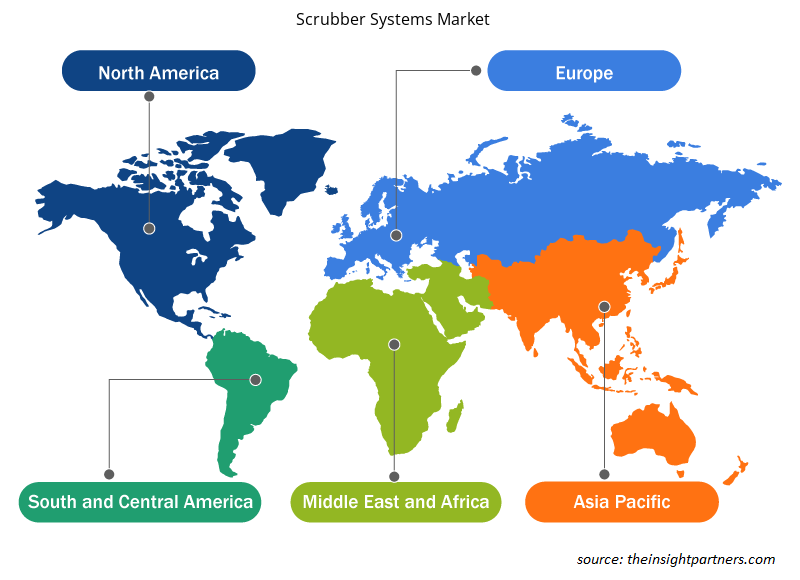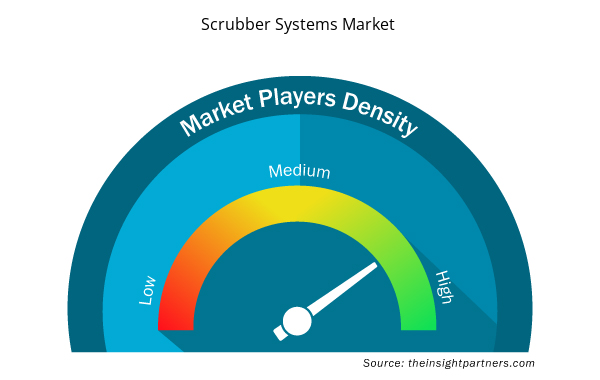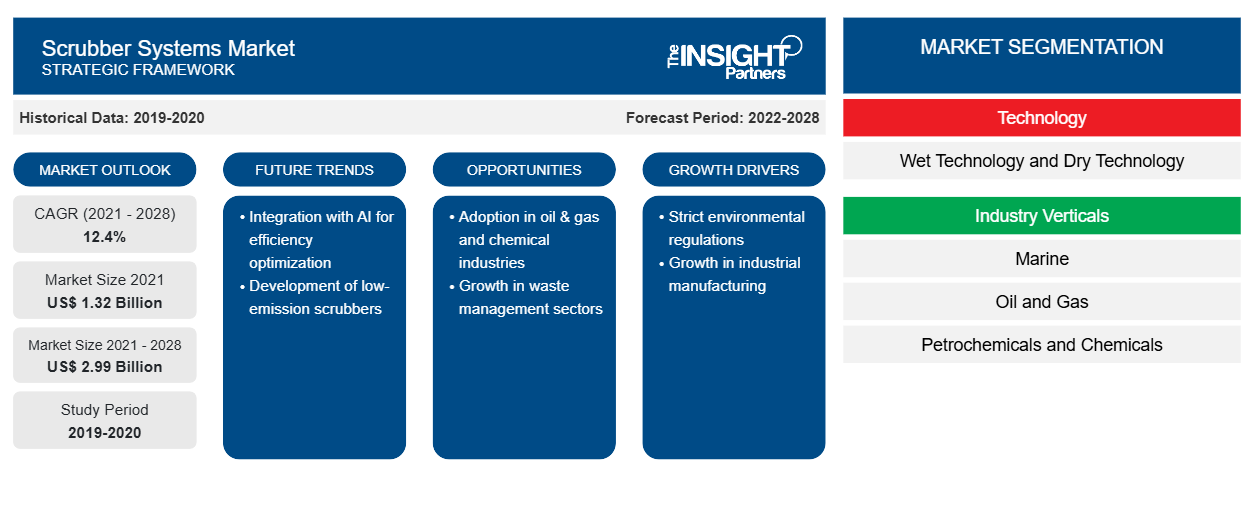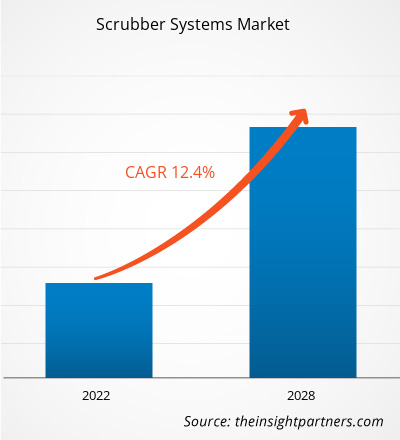بلغت قيمة سوق نظام التنظيف 1,316.0 مليون دولار أمريكي في عام 2021 ومن المتوقع أن تصل إلى 2,989.2 مليون دولار أمريكي بحلول عام 2028؛ ومن المتوقع أن ينمو بمعدل نمو سنوي مركب قدره 12.4٪ من عام 2021 إلى عام 2028.
تشتهر الصناعات التحويلية الكبرى مثل الأسمنت والزجاج والمواد الكيميائية والبتروكيماوية والأغذية والزراعة والمستحضرات الصيدلانية بانبعاثات الغازات الضارة. وبالتالي، فإن اللوائح البيئية الصارمة المفروضة على هذه الصناعات هي التي تدفع السوق. على سبيل المثال، تعد صناعة الأسمنت واحدة من الصناعات الملوثة الرئيسية لأنها تطلق جزيئات ثاني أكسيد النيتروجين (NO2) وثاني أكسيد الكبريت (SO2) أثناء الإنتاج. بالإضافة إلى ذلك، فإن التجارة الدولية المتزايدة عبر الطرق البحرية وزيادة الأنشطة الترفيهية تدفع نمو سوق نظام الغسيل . يمكن أن يعزى ارتفاع الأعمال البحرية العالمية إلى تكلفة النقل الاقتصادية والطلب العالمي المتزايد باستمرار على السلع والمنتجات البترولية. علاوة على ذلك، فإن المشاركة المتزايدة في الأنشطة الترفيهية مثل إجازات الرحلات البحرية والرحلات الدولية تعزز استخدام السفن البحرية وبالتالي تغذي نمو سوق نظام الغسيل.
تأثير جائحة كوفيد-19 على سوق أنظمة التنظيف
وقد شهد تفشي فيروس كورونا المستجد (كوفيد-19) المفاجئ تأثيرًا سلبيًا كبيرًا على الطلب على صناعة أنظمة تنقية الغاز في أعقاب الوباء العالمي. في أغسطس 2020، حولت شركة يارا مارين تكنولوجيز - إحدى الشركات الرائدة في مجال أنظمة تنقية الغاز البحرية - تركيزها بعيدًا عن السوق بسبب فيروس كورونا المستجد (كوفيد-19) وانخفاض أسعار النفط. وذكر مدير الابتكار في الشركة أن لديهم آمالًا كبيرة في عام 2020 على أنظمة تنقية الغاز، لكن فيروس كورونا المستجد (كوفيد-19) غير كل شيء. ومع ذلك، شهد السوق ارتفاعًا في الطلب منذ الربع الثالث حيث أدخلت العديد من الحكومات لوائح صارمة للحفاظ على الهواء النقي. تلعب أنظمة تنقية الهواء دورًا حيويًا في إزالة الجزيئات الخطرة من العادم، مما يدعم السوق لاستعادة زخمه.
قم بتخصيص هذا التقرير ليناسب متطلباتك
ستحصل على تخصيص لأي تقرير - مجانًا - بما في ذلك أجزاء من هذا التقرير، أو تحليل على مستوى الدولة، وحزمة بيانات Excel، بالإضافة إلى الاستفادة من العروض والخصومات الرائعة للشركات الناشئة والجامعات
- احصل على أهم اتجاهات السوق الرئيسية لهذا التقرير.ستتضمن هذه العينة المجانية تحليلاً للبيانات، بدءًا من اتجاهات السوق وحتى التقديرات والتوقعات.
رؤى السوق –
سوق أنظمة التنظيف
زيادة في التجارة البحرية العالمية والأنشطة الترفيهية
إن ارتفاع التجارة الدولية عبر الطرق البحرية وزيادة الأنشطة الترفيهية تعمل على دفع نمو سوق أنظمة تنقية الغازات العادمة. ويمكن أن يعزى ارتفاع الأعمال البحرية العالمية إلى تكاليف النقل الاقتصادية والطلب العالمي المتزايد باستمرار على السلع والمنتجات البترولية. وعلاوة على ذلك، فإن المشاركة المتزايدة في الأنشطة الترفيهية مثل إجازات الرحلات البحرية والرحلات الدولية تعمل على زيادة استخدام السفن البحرية وبالتالي تغذية نمو سوق أنظمة تنقية الغازات العادمة. ويمكن أن يعزى ارتفاع الأنشطة الترفيهية إلى زيادة دخل الفرد من المستهلكين. وبالتالي، فإن الزيادة في انبعاثات الكبريت من السفن - بسبب ازدهار التجارة العالمية - وتصاعد النقل البحري عبر الاقتصادات النامية والمتقدمة تعمل على تعزيز تركيبات أنظمة تنقية الغازات العادمة.
رؤى مبنية على التكنولوجيا
بناءً على التكنولوجيا، يتم تقسيم سوق أنظمة التنظيف إلى تكنولوجيا رطبة وتكنولوجيا جافة. احتلت شريحة التكنولوجيا الرطبة حصة سوقية أكبر في عام 2021.
يركز اللاعبون العاملون في سوق نظام التنظيف بشكل أساسي على تطوير المنتجات المتقدمة والفعالة.
- في يوليو 2021، أعلنت شركة Babcock & Wilcox Environmental أنها ستدعم طلب مركز Amager Resource Center لبناء منشأة متقدمة لالتقاط ثاني أكسيد الكربون في منشأة Amager-Bakke (Copenhill) لتحويل النفايات إلى طاقة التابعة لـ ARC في كوبنهاجن، الدنمارك، مقابل أكثر من 140 مليون دولار أمريكي.
- في سبتمبر 2021، قدمت شركة DuPont Clean Technologies حلاً مبتكرًا ومتقدمًا لقمع أعمدة البخار لأنظمة تنقية الغاز MECS DynaWave في تطبيقات وحدات استعادة الكبريت (SRU). توفر Sennuba التحكم الموثوق في التآكل وقمع أعمدة البخار في نظام التنقية مع الحد الأدنى من خطر الانسداد.
رؤى إقليمية حول سوق أنظمة التنظيف
لقد قام المحللون في Insight Partners بشرح الاتجاهات والعوامل الإقليمية المؤثرة على سوق أنظمة التنظيف طوال فترة التوقعات بشكل شامل. يناقش هذا القسم أيضًا قطاعات سوق أنظمة التنظيف والجغرافيا في جميع أنحاء أمريكا الشمالية وأوروبا ومنطقة آسيا والمحيط الهادئ والشرق الأوسط وأفريقيا وأمريكا الجنوبية والوسطى.

- احصل على البيانات الإقليمية المحددة لسوق أنظمة التنظيف
نطاق تقرير سوق أنظمة التنظيف
| سمة التقرير | تفاصيل |
|---|---|
| حجم السوق في عام 2021 | 1.32 مليار دولار أمريكي |
| حجم السوق بحلول عام 2028 | 2.99 مليار دولار أمريكي |
| معدل النمو السنوي المركب العالمي (2021 - 2028) | 12.4% |
| البيانات التاريخية | 2019-2020 |
| فترة التنبؤ | 2022-2028 |
| القطاعات المغطاة | حسب التكنولوجيا
|
| المناطق والدول المغطاة | أمريكا الشمالية
|
| قادة السوق وملفات تعريف الشركات الرئيسية |
|
كثافة اللاعبين في سوق أنظمة التنظيف: فهم تأثيرها على ديناميكيات الأعمال
يشهد سوق أنظمة التنظيف نموًا سريعًا، مدفوعًا بالطلب المتزايد من المستخدم النهائي بسبب عوامل مثل تفضيلات المستهلك المتطورة والتقدم التكنولوجي والوعي المتزايد بفوائد المنتج. ومع ارتفاع الطلب، تعمل الشركات على توسيع عروضها والابتكار لتلبية احتياجات المستهلكين والاستفادة من الاتجاهات الناشئة، مما يؤدي إلى زيادة نمو السوق.
تشير كثافة اللاعبين في السوق إلى توزيع الشركات أو المؤسسات العاملة في سوق أو صناعة معينة. وهي تشير إلى عدد المنافسين (اللاعبين في السوق) الموجودين في مساحة سوق معينة نسبة إلى حجمها أو قيمتها السوقية الإجمالية.
الشركات الرئيسية العاملة في سوق أنظمة التنظيف هي:
- شركة بابكوك وويلكوكس إنتربرايزز
- ألفا لافال
- شركة دوبونت دي نيمورس
- شركة فوجي الكهربائية المحدودة
- مجموعة جي إي أيه أيه جي
إخلاء المسؤولية : الشركات المذكورة أعلاه ليست مرتبة بأي ترتيب معين.

- احصل على نظرة عامة على أهم اللاعبين الرئيسيين في سوق أنظمة التنظيف
تم تقسيم سوق نظام التنظيف على النحو التالي:
سوق أنظمة التنظيف – حسب التكنولوجيا
سوق أنظمة التنظيف – حسب القطاعات الصناعية
- بحري
- النفط والغاز
- البتروكيماويات والمواد الكيميائية
- الغذاء والزراعة
- معالجة مياه الصرف الصحي
- الرعاية الصحية
- آحرون
سوق أنظمة التنظيف حسب المنطقة الجغرافية
- أمريكا الشمالية
- نحن
- كندا
- المكسيك
- أوروبا
- ألمانيا
- فرنسا
- إيطاليا
- المملكة المتحدة
- روسيا
- بقية أوروبا
- آسيا والمحيط الهادئ (APAC)
- الصين
- الهند
- اليابان
- كوريا الجنوبية
- تايلاند
- بقية منطقة آسيا والمحيط الهادئ
- الشرق الأوسط وأفريقيا
- جنوب أفريقيا
- باقي منطقة الشرق الأوسط وأفريقيا
- أمريكا الجنوبية
- البرازيل
- الأرجنتين
- بقية سام
سوق أنظمة التنظيف – نبذة عن الشركة
- شركة بابكوك وويلكوكس إنتربرايزز
- ألفا لافال
- شركة دوبونت دي نيمورس
- شركة فوجي الكهربائية المحدودة
- مجموعة جي إي أيه أيه جي
- شركة وارتسيلا
- هامون
- يارا للتكنولوجيا البحرية
- مجموعة فيرانتيس للحلول البيئية
- سيكو للبيئة
- التحليل التاريخي (سنتان)، السنة الأساسية، التوقعات (7 سنوات) مع معدل النمو السنوي المركب
- تحليل PEST و SWOT
- حجم السوق والقيمة / الحجم - عالميًا وإقليميًا وقطريًا
- الصناعة والمنافسة
- مجموعة بيانات Excel



Report Coverage
Revenue forecast, Company Analysis, Industry landscape, Growth factors, and Trends

Segment Covered
This text is related
to segments covered.

Regional Scope
North America, Europe, Asia Pacific, Middle East & Africa, South & Central America

Country Scope
This text is related
to country scope.
الأسئلة الشائعة
The scrubber system market in Europe is sub-segmented into France, Germany, Russia, Italy, the UK, and the Rest of Europe. Compared with the Nordic and Eastern European countries, western European countries are more developed and technologically advanced. EU is increasingly stringent policies to observe the numerous constituents of air which is anticipated to propel the growth of the scrubber system market. Also, despite the EU proposals, all member states of the IMO again approved scrubbing system technology as an accepted compliance method. According to European exports, Germany is one of the essential countries for deploying marine scrubbers in long voyage vessels.
The rising application of sulfur dioxide (SOx) removal scrubber technology in the marine industry has gained significant traction in recent years. It is expected to propel the growth of the scrubber system market in the coming years. The SOx removal scrubber technology offers three different scrubber technology variants based on the vessel's operating profile, such as open-loop scrubber technology, closed-loop scrubber technology, and hybrid scrubber technology. The open-loop scrubber technology uses seawater to scrub the exhaust gas. It discharges the sulfuric acid content water back into the sea as the natural alkalinity of seawater neutralizes the acid.
Marine segment of the scrubber system market comprises ship industries including passenger and cargo. Marine segment holds the largest revenue of the scrubber system market and anticipated to maintain its dominance in the coming years. The growth of the segment can be attributed to the rising stringent policies for the ship industry. For instance, In January 2020, International Maritime Organization (IMO) has changed the emission rules and limits the sulphur in the fuel oil used on board ships operating outside designated emission control areas to 0.5% m/m (mass by mass) previously the limit was 3.5%. Similarly, within specific designated emission control areas the limits are 0.1% m/m.
The wet technology segment of the scrubber system market is poised to grow with significant during the estimated period. The growth of the segment can be attributed to its large application in a wide range of industries such as oil and gas, petrochemicals, marine, wastewater treatment, electronics and semiconductor, and others. For instance, CECO Environmental Corp. is providing CECO HEE-Duall Scrubber (a wet scrubber system) to leading global semiconductor chip manufacturers for removing harmful gaseous contaminants. The technology facilitates an efficient air pollution control methods for eliminating particles as well as gases from industrial exhaust streams. The Wet scrubber technology are considered the most appropriate device for air pollution control which collects both gas and particulates in a single system.
Major manufacturing industries such as cement, glass, chemical and petrochemical, food and agriculture, and pharmaceuticals are known for harmful gas emissions. Hence, the stringent environmental regulations on these industries are driving the market. For instance, the cement industry is one of the major polluting industries as it releases nitrogen dioxide (NO2) and sulfur dioxide (SO2) particulate during production.
The rapid industrialization in developing economies is creating a lucrative opportunity for scrubber system manufacturers to augment their market share further. The growing industrial activities in developing economies such as China, India, Brazil, and Vietnam result in more establishments of plants and factories of various industries. In this rapid industrialization era, the developing economies are witnessing a surge in new production facilities or capacities of the manufacturing industries such as cement, glass, petrochemicals and chemicals, oil & gas, food & beverages, pharmaceuticals, mining & metallurgy, and pulp & paper. For instance, China's National Bureau of Statistics (NBS) has reported a 1.6% year-on-year rise in cement production to 2.377 billion tons for 2020. Also, the country is witnessing constructions of 3,203 cement factory projects, which started in December 2020, with a total investment of US$ 415.6 billion.
The List of Companies - Scrubber System Market
- Babcock & Wilcox Enterprises, Inc
- Alfa Laval
- DuPont de Nemours, Inc.
- FUJI ELECTRIC CO., LTD.
- GEA Group AG
- Wärtsilä Corporation
- Hamon
- Yara Marine Technologies
- Verantis Environmental Solutions Group
- CECO Environmental
The Insight Partners performs research in 4 major stages: Data Collection & Secondary Research, Primary Research, Data Analysis and Data Triangulation & Final Review.
- Data Collection and Secondary Research:
As a market research and consulting firm operating from a decade, we have published and advised several client across the globe. First step for any study will start with an assessment of currently available data and insights from existing reports. Further, historical and current market information is collected from Investor Presentations, Annual Reports, SEC Filings, etc., and other information related to company’s performance and market positioning are gathered from Paid Databases (Factiva, Hoovers, and Reuters) and various other publications available in public domain.
Several associations trade associates, technical forums, institutes, societies and organization are accessed to gain technical as well as market related insights through their publications such as research papers, blogs and press releases related to the studies are referred to get cues about the market. Further, white papers, journals, magazines, and other news articles published in last 3 years are scrutinized and analyzed to understand the current market trends.
- Primary Research:
The primarily interview analysis comprise of data obtained from industry participants interview and answers to survey questions gathered by in-house primary team.
For primary research, interviews are conducted with industry experts/CEOs/Marketing Managers/VPs/Subject Matter Experts from both demand and supply side to get a 360-degree view of the market. The primary team conducts several interviews based on the complexity of the markets to understand the various market trends and dynamics which makes research more credible and precise.
A typical research interview fulfils the following functions:
- Provides first-hand information on the market size, market trends, growth trends, competitive landscape, and outlook
- Validates and strengthens in-house secondary research findings
- Develops the analysis team’s expertise and market understanding
Primary research involves email interactions and telephone interviews for each market, category, segment, and sub-segment across geographies. The participants who typically take part in such a process include, but are not limited to:
- Industry participants: VPs, business development managers, market intelligence managers and national sales managers
- Outside experts: Valuation experts, research analysts and key opinion leaders specializing in the electronics and semiconductor industry.
Below is the breakup of our primary respondents by company, designation, and region:

Once we receive the confirmation from primary research sources or primary respondents, we finalize the base year market estimation and forecast the data as per the macroeconomic and microeconomic factors assessed during data collection.
- Data Analysis:
Once data is validated through both secondary as well as primary respondents, we finalize the market estimations by hypothesis formulation and factor analysis at regional and country level.
- Macro-Economic Factor Analysis:
We analyse macroeconomic indicators such the gross domestic product (GDP), increase in the demand for goods and services across industries, technological advancement, regional economic growth, governmental policies, the influence of COVID-19, PEST analysis, and other aspects. This analysis aids in setting benchmarks for various nations/regions and approximating market splits. Additionally, the general trend of the aforementioned components aid in determining the market's development possibilities.
- Country Level Data:
Various factors that are especially aligned to the country are taken into account to determine the market size for a certain area and country, including the presence of vendors, such as headquarters and offices, the country's GDP, demand patterns, and industry growth. To comprehend the market dynamics for the nation, a number of growth variables, inhibitors, application areas, and current market trends are researched. The aforementioned elements aid in determining the country's overall market's growth potential.
- Company Profile:
The “Table of Contents” is formulated by listing and analyzing more than 25 - 30 companies operating in the market ecosystem across geographies. However, we profile only 10 companies as a standard practice in our syndicate reports. These 10 companies comprise leading, emerging, and regional players. Nonetheless, our analysis is not restricted to the 10 listed companies, we also analyze other companies present in the market to develop a holistic view and understand the prevailing trends. The “Company Profiles” section in the report covers key facts, business description, products & services, financial information, SWOT analysis, and key developments. The financial information presented is extracted from the annual reports and official documents of the publicly listed companies. Upon collecting the information for the sections of respective companies, we verify them via various primary sources and then compile the data in respective company profiles. The company level information helps us in deriving the base number as well as in forecasting the market size.
- Developing Base Number:
Aggregation of sales statistics (2020-2022) and macro-economic factor, and other secondary and primary research insights are utilized to arrive at base number and related market shares for 2022. The data gaps are identified in this step and relevant market data is analyzed, collected from paid primary interviews or databases. On finalizing the base year market size, forecasts are developed on the basis of macro-economic, industry and market growth factors and company level analysis.
- Data Triangulation and Final Review:
The market findings and base year market size calculations are validated from supply as well as demand side. Demand side validations are based on macro-economic factor analysis and benchmarks for respective regions and countries. In case of supply side validations, revenues of major companies are estimated (in case not available) based on industry benchmark, approximate number of employees, product portfolio, and primary interviews revenues are gathered. Further revenue from target product/service segment is assessed to avoid overshooting of market statistics. In case of heavy deviations between supply and demand side values, all thes steps are repeated to achieve synchronization.
We follow an iterative model, wherein we share our research findings with Subject Matter Experts (SME’s) and Key Opinion Leaders (KOLs) until consensus view of the market is not formulated – this model negates any drastic deviation in the opinions of experts. Only validated and universally acceptable research findings are quoted in our reports.
We have important check points that we use to validate our research findings – which we call – data triangulation, where we validate the information, we generate from secondary sources with primary interviews and then we re-validate with our internal data bases and Subject matter experts. This comprehensive model enables us to deliver high quality, reliable data in shortest possible time.


 احصل على عينة مجانية لهذا التقرير
احصل على عينة مجانية لهذا التقرير